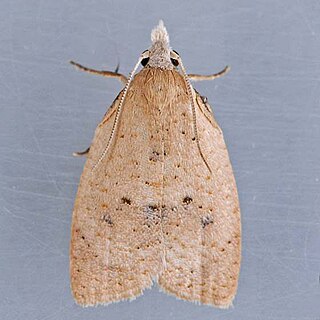Related Research Articles
Bathypluta is a genus of moths belonging to the subfamily Tortricinae of the family Tortricidae.
Hilarographa celebesiana is a species of moth of the family Tortricidae. It is found on Sulawesi.
Mictopsichia panamae is a species of moth of the family Tortricidae. It is found in Panama.
Pseudatteria dognini is a species of moth of the family Tortricidae. It is found in Ecuador.
Sparganothoides teratana is a species of moth of the family Tortricidae. It is found in Panama and Honduras.
Sparganothoides hydeana is a species of moth of the family Tortricidae. It is found from the mountains of Arizona, Colorado and New Mexico in the United States south to Puebla in Mexico. The habitat consists of coniferous forests, pinyon-juniper, oak-cottonwood, and willow-Rhus associations.
Sparganothoides calthograptana is a species of moth of the family Tortricidae. It is found in north-western Hidalgo and the Popocatépetl Park in Mexico.
Sparganothoides audentiana is a species of moth of the family Tortricidae. It is found in Mexico in the states of Tamaulipas and Nuevo Leon.
Sparganothoides xenopsana is a species of moth of the family Tortricidae. It is found in Puebla, Mexico.
Sparganothoides licrosana is a species of moth of the family Tortricidae. It is found in Sinaloa, Mexico.

Sparganothoides lentiginosana, the lentiginos moth, is a species of moth of the family Tortricidae. It is found in the United States from Maryland to Florida, west to Arkansas, Texas and Oklahoma, ranging south to Mexico in Tamaulipas and Veracruz. It is found in a wide range of habitats, ranging from urban areas to mixed pine-deciduous woodlands at low elevations.
Sparganothoides cornutana is a species of moth of the family Tortricidae. It is found from Mexico, south into Guatemala. The habitat consists of mixed broadleaf woods.
Sparganothina ternaria is a species of moth of the family Tortricidae. It is found in Sinaloa, Mexico.

Sparganothis directana, the chokecherry leafroller moth, is a species of moth of the family Tortricidae. It is found in North America from Ontario to Florida, west to Texas and Michigan.
Pentacitrotus vulneratus is a species of moth of the family Tortricidae. It is found in China and India.
Proeulia gielisi is a species of moth of the family Tortricidae. It is found in Santiago Province, Chile.
Saphenista bimaculata is a species of moth of the family Tortricidae. It is found in Costa Rica.
Sparganothina costaricana is a species of moth of the family Tortricidae. It is found in Costa Rica.
Rutilograptis cornesi is a species of moth of the family Tortricidae. It is found in Nigeria.

Dichrorampha vancouverana, the tanacetum root moth, is a moth of the family Tortricidae.
References
- ↑ tortricidae.com
- ↑ Kawabe, A., 1993: A new species of Bathypluta Diakonoff from Sulawesi (Tortricidae). Tyô to Ga, 43 (4): 237-238. Abstract and full article: .
- ↑ Early stages of the Ceracidae (Lepidoptera) with remarks on the true position of the group